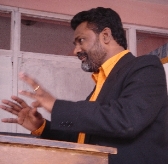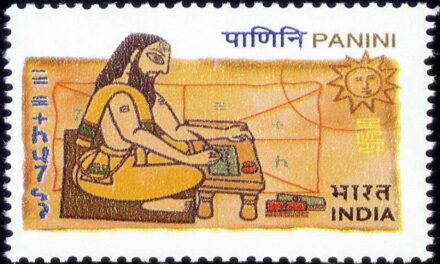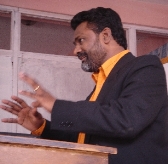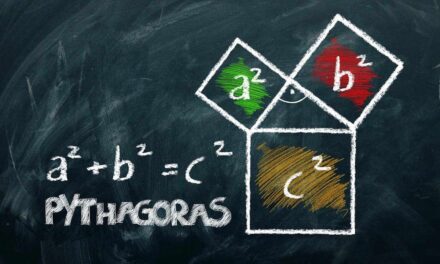 There is nothing called Hinduism. It is rather Hinduisms, because there isn’t one religion called ‘Hinduism’, but there is a multiplicity of religions within what we call Hinduism, ‘a parliament of religions’. It is a very complex system with many different and even contradictory belief systems within itself and hence I prefer ‘Hinduisms’. Rev. Sudhakar Mondithoka, Visiting Professor of 'Contemporary World Religions & Christian Apologetics' and 'Ethics' at SAIACS and Pastor of the English Congregation of Centenary Baptist Church, Secunderabad
There is nothing called Hinduism. It is rather Hinduisms, because there isn’t one religion called ‘Hinduism’, but there is a multiplicity of religions within what we call Hinduism, ‘a parliament of religions’. It is a very complex system with many different and even contradictory belief systems within itself and hence I prefer ‘Hinduisms’. Rev. Sudhakar Mondithoka, Visiting Professor of 'Contemporary World Religions & Christian Apologetics' and 'Ethics' at SAIACS and Pastor of the English Congregation of Centenary Baptist Church, Secunderabad
|
We cannot pointedly say when exactly the Hindu religions had stared. Different people identity the beginnings of Hinduisms variously. But the history of this group of religions can be broadly classified[1] into the following four periods: · The Vedic and Pre-Vedic Period/Hinduism(s) – 3rd Millennium to 8th C BC · The Classical Period/Hinduism (s) – 8th C BC to 1000 AD · The Medieval Period/Hinduism (s) – 1000 to 1800 AD · The Modern Period/Hinduism (s) – 1800 to the Present |
| There is a slightly different way of looking at this issue of the history of Hinduism(s) or Hinduism in the process of growth and evolution or gradual development[2] and this goes with the three ways that are there to attain moksha, in the sense that the three phases of the historical development of Hinduism roughly correspond to the three ways: the way of works, the way of knowledge, and the way of devotion: |
| The Way | The Time of Origin | The Scriptures | The Practices | ||
| Works or Brahmanism or Vedic Hinduism | 1500 BC | Vedas, Sutras, Brahmanas (commentaries on the Vedas), Code of Manu | Detailed observance of laws and rituals, governed by priests | ||
Knowledge or Vedantic or Upanishadic Hinduism |
500 BC |
Upanishads (Vedanta), commentaries on the Vedas | Mystical recognition of Atman-Brahman identity, withdrawal | ||
| Devotion (Bhakti) – most of the Contemporary Hinduism | 200 BC to AD 800 | Bhagavad-Gita,Tamil Poetry, Puranas | Attachment to one god or goddess, three main schools: Vaishnavism, Shaivism, Shaktism | ||
|
Although the development has taken place in these three phases and the most predominant contemporary strand is the Bhakti one, there is always some overlapping and vagueness in the way people practice their brand of religion. The Vedic gods, a collection of deities is a fluid pantheon consisting of many gods, although 33 is used as a symbolic representation of their number.
The following are some examples: |
|||||
|
1). Dyaus Pitar – the original sky god, 2). Prithvi Mater- mother earth, 3) Varuna – the god of the sky, 4) Indra – the king of the heavens, 5) Mitra – the sun god associated with moral and ritual purity, 6) Rita – the god of truth and right, 7) Vishnu – a minor god in the Vedas, 8) Rudra – capricious, sometimes malicious mountain god that was more feared than worshipped and came to be later known as Shiva, the auspicious one, 9) Agni – the god of fine, 10) Some – the god of the sacred drink. Brahmanaspati was the word spoken at the sacrifice and later on the word itself became a god and eventually the highest conception of God in certain forms of Hinduism.
The case system is integral to the Vedic Hinduism, because the Chaturvarna System is there in the Vedas and the Karma-Samsara concept supports this and the goal of Hinduism(s) seems to be finding release from the Karma-Samsara cycle, Moksha. The Vedantic Hinduism also had undergone a long process of change over centuries with different schools (Sankara’s Advaita, Ramanuja’s Visistadvaita, and Madhva’s Dvaita) claiming their authority to be the same Upanishads, the Vedanta (= the end of Vedas or the supplements to the Vedas).
The Vedantic Religious Philosophy is very speculative and abstract in nature and has always remained a minor part of Hinduism. But Sankara and then Vivekananda and before him Rama Krishna Paramahamsa, made it popular. The Bhakti is mainly about ‘loving attachment’ where the lover of a god or goddess devotes himself or herself totally to the chosen deity and this is believed to provide salvation. Bhakti seems to be at the heart of most of the contemporary Hinduism. Here again there is a marriage between the two end of the spectrum of Hindu beliefs, the Advaita and Polytheism and the Trimurtis (Brahma, Vishnu, and Mahesh or Shiva) are believed to be the manifestations of Brahman. The number of gods and goddesses is further multiplied here and it is popularly said that there are 330 million gods (a very sharp increase from the 33 devas of the Rig-Veda) and just saying all their names at the rate of 1in 5 seconds would take fifty-two years. This number is an exaggeration meant to emphasize the multitude of gods that is there in the Hindu religions.
|
|||||
|
As in the other aspects, as we have already seen some here also there is much variety and width, diversity, and complexity. The Scriptures are classified into two broad classes or groups: 1) Srutis or Shruthis – that which has been heard, primary authority, the Vedas, codified into four by Veda Vyasa (and his disciples – Paila, Vaisampayana, Jaimini, and Sumanta, taught to their disciples and so on) but originally perceived or heard by the Rishis, the sages or seers who performed thapasya or meditated, and
2) Smritis – that which is remembered, human compositions with the following groups:
a) The Epics – or the Ithihasas (the Suhrit Samhitas = friendly compositions) in the form of parables and stories for the common folks, like Ramayana of Valmiki, Mahabharata of Vyasa (with 110, 000 couplets or 220, 000 lines in 18 chapters or Parvas or sections and Harivamsa Parva is an appendix with 16, 375 verses), the Yogavasishta, and the Harivamsa, the first tow being the most popular and Bhagavad-Gita, a section of Mahabharata, being the most well known or popular among all in modern times
b) The Puranas – tales and short stories which convey the truths of the Vedas and Smritis, 18-18 in all, the most popular being the Bhagavata, Vishnu, and Markandeya Puranas. The stories of Prahlada, Sati Savitri, Sati Sukanya, Dhruva, Markandeya, Shranana, King Usinara, King Harischandra or Satya Harischandra, Sudama or Kuchela etc are from the Puranas. We also read about the Dasa-Avataras of Vishnu, in fact some of the stories are around an avatar
c) Dharma Sashtras – the books of law or dharma
d) The Agamas – those that lay down the separate theological disciplines and doctrines for the worship of different deities. Eg. Vaishnava Agamas like the Pancharatra and the Vaikhanasa that glorify Vishnu, Shaiva Agamas that glorify Shiva and led to Shaiva Sidhanta in the South, and Shakta Agama that glorifies Devi, the Consort of Shiva.
e) The Darsanas, the Shad-Darsanas –
Let us take a look at the rough dates for the composition of the Vedas – the different parts of each of the 4 Vedas: |
|||||
| The Four Vedas: A Chronological Chart(Approximate Dates only)[3] | |||||
| 1500-600 BC Samhitas | 1000-600 BC Brahmanas | 1000-600 BCAranyakas | 600-300 BCUpanishads |
Rigveda(Verses) |
AitareyaKausitaki | AitareyaKausitaki | AitareyaKausitaki |
| Samaveda(Songs or Chants) |
PancavimsaChandogyaTalavakara |
ChandogyaKena | |
| Yajurveda(Mantras) |
Taittiriya
Satapatha |
Taittiriya Brihad | TaittiriyaKathaSvetsvataraHrihadaranyakaIsa |
| Atharva(Magic Spells & Incantations) |
Gopatha |
MundakaPrasnaMandukya |
Click here to read Part 1 and here to read Part 2.
[1] Arvind Sharma, Classical Hindu Thought: An Introduction (New Delhi: Oxford University Press, 2000), xxiv.
[2] Winfried Corduan, Neighboring Faiths: A Christian Introduction to World Religious (Downers Grove: InterVarsity Press, 1998), 190-207.
[3] James F. Lewis and William G. Travis, Religious Traditions of the World (Eugene, Oregon: Wipf and Stock Publishers, 1999), 229.
{moscomment}








🙂 organised ,clear and precise.